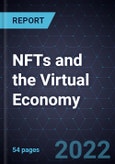A Disruptive Technology Innovation that Serves as the Foundation for the Multibillion-Dollar Virtual Economy
Non-fungible Tokens (NFTs) refer to unique and distinguishable digital assets stored on a distributed ledger/blockchain. Following the emergence of the bitcoin digital currency in early 2009, “colored coins” were coined by Yoni Assia in 2012; these were small parts of bitcoins that represented assets, primarily digital collectibles, and were the predecessor to NFTs.
In 2017, John Watkinson and Matt Hall created CryptoPunks, 24x24 pixel characters that exist on an Ethereum blockchain. Only 10,000 such characters with unique appearances were created, leading to tremendous buzz amongst a community of crypto users who treated ownership as a badge of honor. This served as an inspiration for NFTs, which has now become a potentially lucrative technology, creating value for businesses across the globe.
Key Issues Addressed:
- What is an NFT? What are the defining characteristics of NFTs?
- How are NFTs differentiated from cryptocurrencies?
- What are some of the key market highlights for NFTs to date?
- What are the essential NFT growth drivers and restraints?
- What is the technology behind NFTs? What are the technologies that make up an NFT marketplace?
- What are the key criteria for choosing an NFT platform?
- What are the most popular blockchain platforms available today for NFTs?
- How is digital content distributed by NFTs stored?
- How has the market performed in the last 3 years? What are the key performance indicators?
- Which application areas are most impacted by NFTs? What are the emerging use cases?
- What are the primary growth opportunities in the NFTs for ecosystem stakeholders?
Table of Contents
Companies Mentioned (Partial List)
A selection of companies mentioned in this report includes, but is not limited to:
- OpenSea
- Rarible







